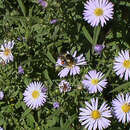en
names in breadcrumbs


Several taxa have been recognized within this variable species. Here, we segregate Symphyotrichum firmum as a distinct entity. The tall, pink-rayed S. elliottii of the outer coastal plains is also distinctive, despite reports of hybrids with S. puniceum var. puniceum where their ranges overlap (see G. L. Nesom 1997b). A recently described member of the complex, S. rhiannon, is an ultramafic endemic from North Carolina. Here, within S. puniceum, we recognize two varieties, the variable and widespread var. puniceum, and var. scabricaule from the inner Gulf coastal plains, following Nesom, who also offered a useful summary of the infraspecific taxonomy of the species.
Symphyotrichum puniceum (formerly Aster puniceus), is a species of flowering plant in the family Asteraceae native to eastern North America. It is commonly known as purplestem aster,[3] red-stalk aster,[4] red-stemmed aster,[5] red-stem aster, and swamp aster.[6] It also has been called early purple aster, cocash, swanweed, and meadow scabish.[7]
Its range extends from the edges of the Great Plains to the Atlantic coast, and from the Gulf coast of Texas north to southern Ungava Bay in the north of Quebec.[3] It is adventive in Europe.[2]
Symphyotrichum puniceum produces flowers between August and October. The ray florets range from dark blue or purple to white (rarely). The disc florets are yellow to cream-colored, becoming pink or purple with maturity.[8]
Symphyotrichum puniceum is a variable species, and many forms have been named.[9] As of July 2021, Plants of the World Online (POWO) accepts one variety in addition to the autonym.[2] S. puniceum var. scabricaule (Shinners) G.L.Nesom occurs in the southern United States from Texas to Alabama.[10] The autonym, S. puniceum var. puniceum, occurs in most of the eastern United States and southern Canada.[11]
The species Symphyotrichum firmum is sometimes considered a variety of S. puniceum, but POWO and Flora of North America treat them as distinct species.[2][8] In 1999, Calvin College botanists David P. Warners and Daniel C. Laughlin gave evidence that they should be considered two distinct species.[12] Compared to S. firmum, Symphyotrichum puniceum is typically hairier, with purpler flowers, and does not form dense colonies but rather small clusters or scattered individuals.[13]
Symphyotrichum puniceum on left and S. firmum on right
Hybrids between this species and Symphyotrichum boreale have been recorded and are called Symphyotrichum × longulum.[14]
As of July 2021, NatureServe listed Symphyotrichum puniceum as Secure (G5) worldwide and Critically Imperiled (S1) in Mississippi.[1] It listed S. puniceum var. puniceum as Vulnerable (S3) in Kentucky,[15] and S. puniceum var. scabricaule as overall an Imperiled Variety (T2) and Critically Imperiled (S1) in Texas.[16]
Symphyotrichum puniceum has been used for medicinal purposes among indigenous people in North America. It has been documented that the Chippewa have smoked the root with tobacco to attract game.[17] Multiple uses have been reported for the Woodland Cree, including as an aid for tooth pain[18] and for healing a woman after childbirth.[19] The Iroquois have used the roots for healing of various ailments including colds,[20] fevers,[21] pneumonia,[22] typhoid,[23] and tuberculosis.[24]
Symphyotrichum puniceum (formerly Aster puniceus), is a species of flowering plant in the family Asteraceae native to eastern North America. It is commonly known as purplestem aster, red-stalk aster, red-stemmed aster, red-stem aster, and swamp aster. It also has been called early purple aster, cocash, swanweed, and meadow scabish.
Its range extends from the edges of the Great Plains to the Atlantic coast, and from the Gulf coast of Texas north to southern Ungava Bay in the north of Quebec. It is adventive in Europe.